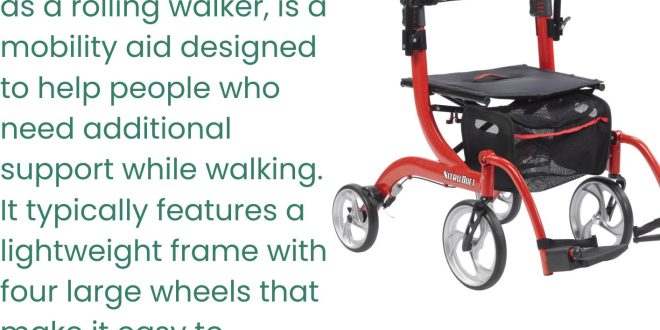Rollators: Enhancing Mobility and Independence
Introduction to Rollators
Rollators, also known as wheeled walkers, are designed to provide stability and ease of movement for individuals with limited mobility. They come with wheels, a seat, and often a braking system, making them ideal for indoor and outdoor use. Unlike traditional walkers, rollators allow users to move freely without lifting the device with each step, enhancing mobility and reducing strain.
A rollator works by providing balance and support through a wheeled frame that the user can push as they walk. Its large wheels allow smooth navigation across a range of surfaces, while hand brakes on the handles ensure it can be stopped quickly for safety. Here’s a breakdown of how a rollator works:
- Walking Support: The user holds onto the handlebars, pushing the rollator forward as they walk. This allows them to lean slightly for extra stability, which is especially useful for those with balance issues or muscle weakness.
- Braking System: The hand brakes allow the user to control the rollator’s speed, especially on slopes or inclines. Squeezing the brakes slows the rollator, while pushing them down engages a lock, making it stable when the user wants to rest.
- Seat and Resting Option: Many rollators come with a padded seat between the handlebars. When the user tires, they can engage the brakes to lock the rollator in place, then sit down to rest.
- Storage and Convenience: A storage bag or basket beneath the seat or attached to the frame lets the user carry personal items hands-free.
Benefits of Using a Rollator
Rollators offer numerous benefits for users, from improved safety to enhanced independence. These aids provide a stable platform, allowing users to move confidently without fearing a fall. Additionally, rollators often feature seats, which give users a convenient place to rest, enabling longer outings without fatigue. Braking systems further increase safety, ensuring control when navigating different terrains.
Types of Rollators
There are several types of rollators, each suited to different needs and preferences:
- Standard Rollators: These come with four wheels and a basic frame, suitable for smooth surfaces and moderate mobility needs.
- Three-Wheeled Rollators: Compact and lightweight, three-wheeled rollators are perfect for maneuvering tight spaces, though they may be less stable on uneven ground.
- Heavy-Duty Rollators: Designed for larger individuals, these rollators provide enhanced stability and durability, often with reinforced frames.
- Rollator Transport Chairs: A hybrid model, this combines the features of a rollator and a wheelchair, allowing users to walk independently or be pushed when needed.
Key Features of Rollators
When choosing a rollator, it’s essential to consider the following features:
- Adjustable Handles: Most rollators come with adjustable handles to accommodate users of different heights, ensuring optimal posture and comfort.
- Seat and Backrest: Many rollators include a seat and a padded backrest, allowing users to rest when necessary.
- Basket or Storage Bag: Rollators often have a storage compartment for carrying essentials, making outings more convenient.
- Braking System: Hand brakes or loop brakes are standard on most rollators, providing control on slopes and uneven surfaces.
The scope of a rollator is extensive, particularly in supporting the mobility and independence of individuals with limited mobility. Here are the main aspects of its scope:
- Mobility Aid: Rollators are designed to aid people with walking difficulties, offering stability and balance to those who struggle with conventional walking aids, such as canes.
- Rehabilitation and Recovery: After surgeries (e.g., hip or knee replacement) or medical conditions affecting mobility, rollators are commonly used in physical therapy and recovery to rebuild strength and confidence in walking.
- Independence for the Elderly: Rollators empower older adults to stay active and independent, enabling them to perform daily activities like shopping, strolling, or visiting friends without the need for constant assistance.
- Safety Enhancement: With features like hand brakes and wide wheels, rollators offer added security, reducing the risk of falls on various terrains, including indoors, sidewalks, and parks.
- Convenience: With foldable designs, storage compartments, and a built-in seat for resting, rollators are convenient for users who need a portable, easy-to-manage aid for daily life.
- Long-term Use: Rollators serve those with chronic conditions (e.g., arthritis, Parkinson’s disease, or multiple sclerosis) who require continuous mobility support, ensuring stability and reducing the physical strain of walking.
How to Choose the Right Rollator
Selecting the right rollator involves assessing individual needs, environment, and preferences. Here are a few tips:
- Consider Terrain: If you’ll be using the rollator outdoors, opt for a model with larger, more durable wheels.
- Weight Capacity: Check the rollator’s weight capacity to ensure it can safely support the user.
- Foldability: Look for a foldable rollator if you need easy storage or plan to transport it frequently.
Using a Rollator Safely
To ensure maximum safety, follow these guidelines when using a rollator:
- Engage Brakes When Stationary: Always engage the brakes when sitting or standing to prevent accidental rolling.
- Avoid Excessive Weight in Storage Bags: Overloading the rollator’s storage bag may cause it to become unbalanced.
- Maintain Proper Posture: Walk upright with the rollator slightly ahead, avoiding leaning heavily on it.
Conclusion
Rollators are valuable mobility aids that provide stability, independence, and safety for individuals with mobility challenges. With various types and features, users can find a rollator suited to their specific needs, enhancing daily activities and enabling a more active lifestyle. Whether for a loved one or personal use, investing in a quality rollator can greatly improve quality of life, restoring confidence and mobility. For more info visit our website Artema med.
 Diverse Perspectives: Insights & Stories Exploring Ideas, Sharing Knowledge
Diverse Perspectives: Insights & Stories Exploring Ideas, Sharing Knowledge





